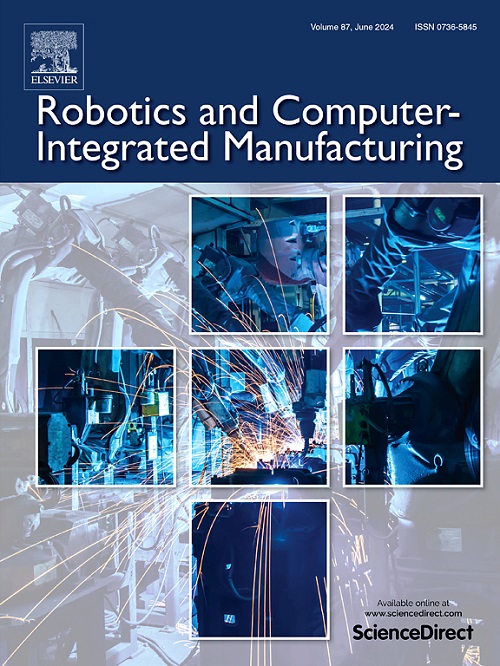Development of a continuum robot with inflatable stiffness-adjustable elements for in-situ repair of aeroengines
IF 11.4
1区 计算机科学
Q1 COMPUTER SCIENCE, INTERDISCIPLINARY APPLICATIONS
引用次数: 0
Abstract
Continuum robots, with their slender configuration and high redundancy, gain increasing interest in industrial applications such as intervention within confined spaces. However, when the robot end effector is required to travel a long distance, the existing products need a large actuation pack and complicated control strategy for a decent accuracy. This paper presents a continuum robot with a novel stiffness-adjustable mechanism designed to address conditions requiring high tip accuracy in long-reach confined spaces. Key innovations include (1) a section capable of inflating its diameter tenfold for the support of a 6-DoF continuum section, (2) a predictive model for a hybrid stiffening arm, and (3) a manual insertion approach that reduces actuation complexity. The proposed design was validated through a prototype that performed repairs on a thermal barrier coating within an aeroengine. During trials, a 12.6 mm diameter arm was inserted through an access port with a diameter of < 15 mm, inflated to 120 mm to securely lock in place, and enabled precise six degrees of freedom (6-DoF) control. The predictive model achieved a Root Mean Square Error below 1.14 mm under payload, demonstrating enhanced positional accuracy compared to traditional continuum robots. These results mark a significant advancement towards robust, precise operations in restricted industrial environments.
航空发动机原位维修用充气刚度可调单元连续体机器人的研制
连续体机器人以其细长的结构和高冗余度,在工业应用中越来越受到关注,例如在密闭空间内进行干预。然而,当要求机器人末端执行器进行长距离运动时,现有产品需要较大的驱动包和复杂的控制策略才能获得较好的精度。本文提出了一种具有新型刚度可调机构的连续体机器人,旨在解决在长距离密闭空间中对尖端精度的要求。关键的创新包括:(1)能够将其直径膨胀十倍以支持6自由度连续剖面的截面,(2)混合强化臂的预测模型,以及(3)降低驱动复杂性的手动插入方法。通过对航空发动机内部热障涂层进行修复的原型,验证了所提出的设计。在试验期间,一个直径12.6 mm的机械臂通过一个直径为<;15毫米,膨胀至120毫米,以安全锁定到位,并实现精确的六自由度(6-DoF)控制。该预测模型在有效载荷下的均方根误差低于1.14 mm,与传统连续体机器人相比,显示出更高的定位精度。这些结果标志着在受限工业环境中实现稳健、精确操作的重大进展。
本文章由计算机程序翻译,如有差异,请以英文原文为准。
求助全文
约1分钟内获得全文
求助全文
来源期刊
CiteScore
24.10
自引率
13.50%
发文量
160
审稿时长
50 days
期刊介绍:
The journal, Robotics and Computer-Integrated Manufacturing, focuses on sharing research applications that contribute to the development of new or enhanced robotics, manufacturing technologies, and innovative manufacturing strategies that are relevant to industry. Papers that combine theory and experimental validation are preferred, while review papers on current robotics and manufacturing issues are also considered. However, papers on traditional machining processes, modeling and simulation, supply chain management, and resource optimization are generally not within the scope of the journal, as there are more appropriate journals for these topics. Similarly, papers that are overly theoretical or mathematical will be directed to other suitable journals. The journal welcomes original papers in areas such as industrial robotics, human-robot collaboration in manufacturing, cloud-based manufacturing, cyber-physical production systems, big data analytics in manufacturing, smart mechatronics, machine learning, adaptive and sustainable manufacturing, and other fields involving unique manufacturing technologies.

 求助内容:
求助内容: 应助结果提醒方式:
应助结果提醒方式:


